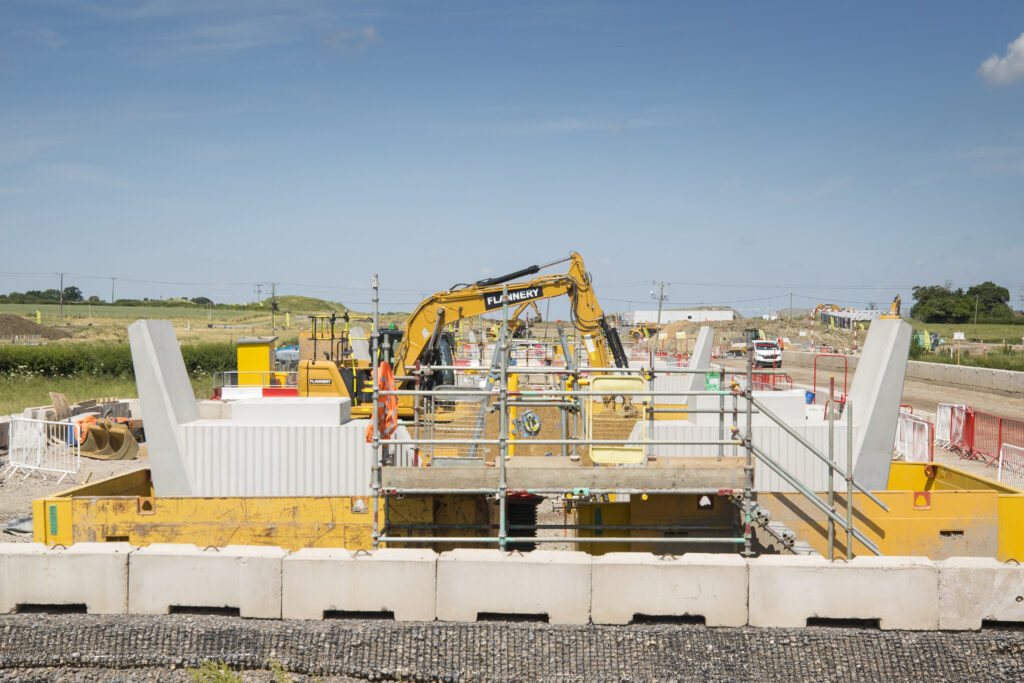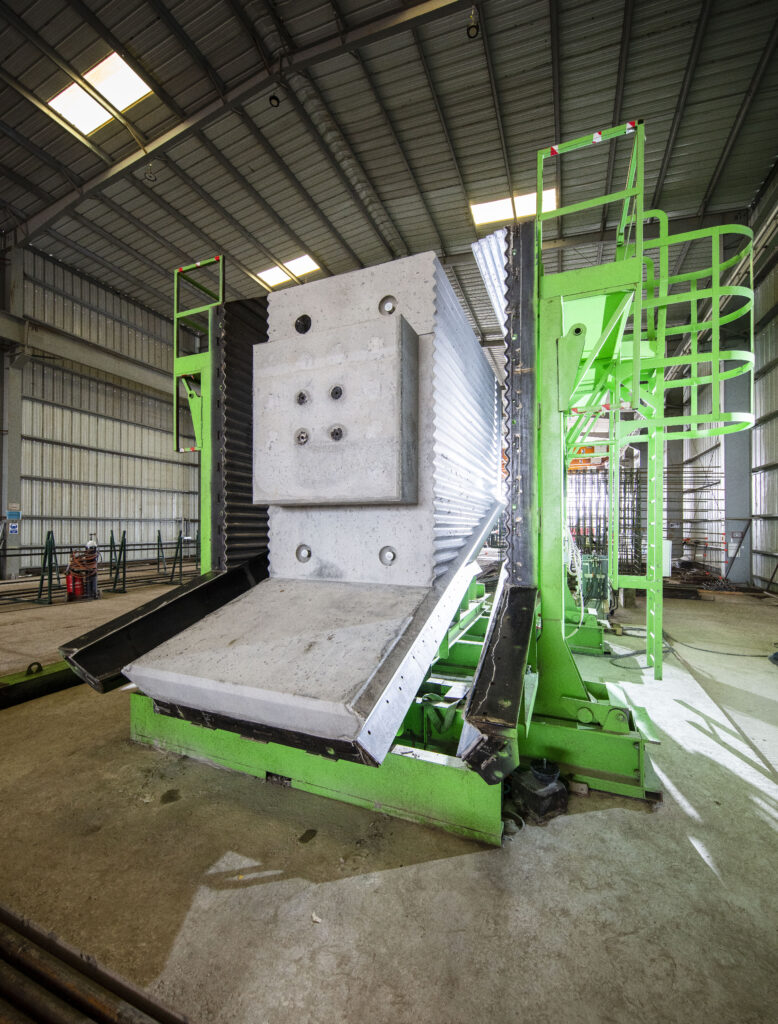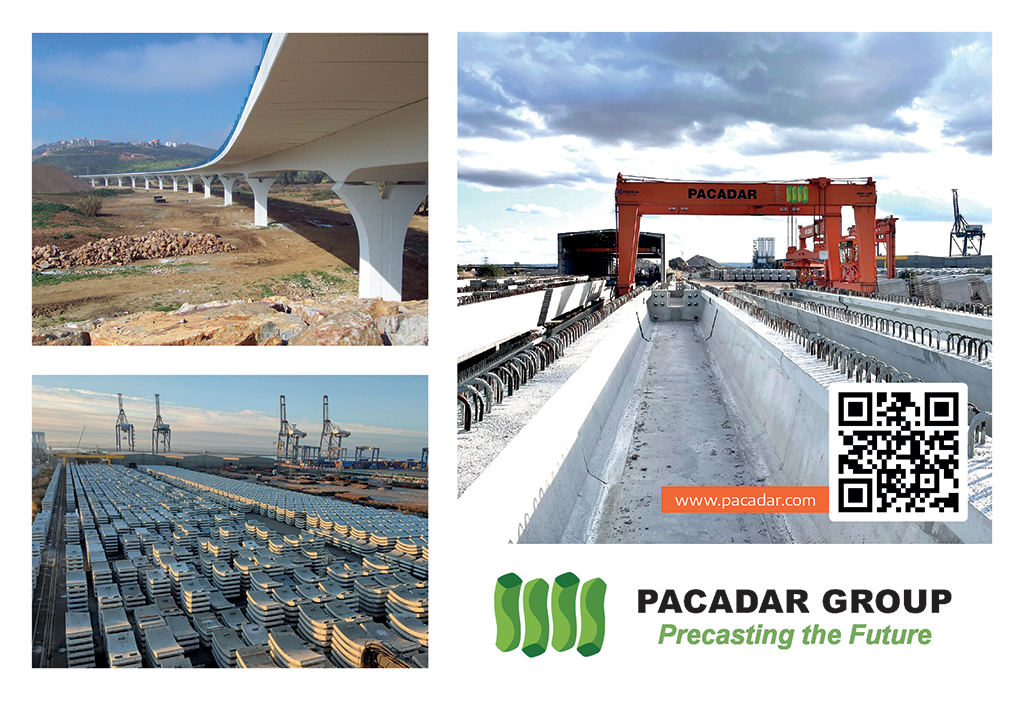The HS2 project has featured in these pages many times before and its industry leading approach continues to demonstrate innovative methods of design and construction.
HS2 plans to be the most sustainable high-speed rail network in the world, with its objective being to reduce embodied emissions by 50% (tCO2e/t) by 2030, compared with 2021 levels. About half of the emissions being produced during Phase 1 are associated with concrete and steel construction materials.
The Thame Valley viaduct carrying HS2 above the River Thame and its flood plain, just outside Aylesbury, is one of 15 being built by Eiffage, Kier, Ferrovial Construction and BAM Nuttall (EKFB). It was chosen to trial an off-site manufactured modular viaduct with every major element of the structure being prefabricated. Set low into the landscape with a simple and consistent profile, the underside of the 880-metre-long viaduct will be just three metres above the ground, with 36 spans crossing the river and surrounding flood plain and wetlands.
Tomas Garcia, HS2’s head of civils structures, and Tiago Palas, head of operations for FC Civils Solutions, explained to Rail Engineer the innovative features and benefits of the design and installation of this landmark viaduct.
The design is of lighter weight than the indicative design and this, together with reduced transport, will save around 19,000 tonnes of embodied carbon, reducing its carbon footprint by a third. Tomas said: “We’re serious about cutting embedded carbon in construction, reducing cost and programme and improving safety, performance and durability. Thame Valley is a great example of how our contractors are embracing the latest engineering techniques to do just that.”
Designed by EKFB, the precast elements are being manufactured by PACADAR UK, at its factory at Isle of Grain in Kent, and installed by construction partner, FC Civils Solutions, using its experience of constructing similar prefabricated structures.
Alternative design
The Thame Valley Viaduct is one of HS2’s Key Design Elements as it is located close to a residential area and in recognition of the community’s interest in the River Thame corridor. As a result, the HS2 team held a public engagement event early in 2020 to present the proposals and gather comments.
The viaduct will be partially visible from public rights of way to the south-west but, elsewhere, is largely obscured by a combination of gentle folds in the landscape and existing hedgerows and trees. As a result, the project was generally seen as uncontentious but some valuable local commentary on the design was received.
EKFB worked with its design partner ASC, a joint venture between Arcadis Setec and COWI, to develop the design. The original indicative design for the viaduct was for pairs of precast hollow pier shells that would be filled on site. These would then support four narrow hollow beams that would be joined together at each end by a cast in-situ cross beam above both piers. On these would be formed an in situ concrete deck and parapets.


Applying lessons from the construction of recent high-speed rail projects in Spain, the alternative developed by the team is based on a modular design which has been widely implemented by PACADAR. This was for fully formed solid piers that could be brought to site complete and simply plugged into the pile caps. On these would be just two wide hollow beams that, unlike the narrow beams, would not require a cross beam for stability but would be connected simply by a reinforced in-situ deck formed on permanent precast concrete planks. The abutments will be cast in situ as a precast solution was not practical.
The pretensioned hollow beams will be coupled to the next beams through thickened end walls using post tensioned bars. In this way a continuously tensioned deck will be created, with all main elements of the structure always in compression. As a result, there will be no tendency to micro-cracking, resulting in much enhanced long-term durability.
Positive aesthetics
Architects are involved in most of HS2’s projects to ensure positive aesthetics that enhance their surroundings. Here specialist architect, Moxon, supported the structural design team and provided a number of features that will help the viaduct to sit comfortably within its landscape.
The spans of the viaduct are relatively short, at around 25 metres, to avoid an unsightly, thick deck. The piers are placed in pairs, one for each side of the deck, so when viewed at an angle, sight lines between the piers to the landscape beyond avoid an apparently continuous line of concrete. The piers have also been detailed to include heavily textured side panels that soften their appearance and, within the central gap between piers, also provide a slot that hides the deck drainage downpipes.
The piers extend upwards to almost connect with the parapet edge, helping to enhance the appearance of a light and narrow structure. This combination of outwardly smooth and inwardly textured surfaces aims to catch the sunlight and draw the eye, minimising the apparent bulk of the piers. The cantilevered sides of the deck provide shading that further soften the structure’s appearance. All external elements are being made at the same location from the same concrete mix components and so the colour will be consistent throughout, something that is not always achievable with on-site construction.
Around the viaduct, the river floodplain will be enhanced to boost biodiversity and help better manage flood water. This will include replacing existing arable land with new wildlife-rich areas of woodland and wetland.
The design process involved reviews and approval by Aylesbury Vale District Council and the design received positive feedback from the HS2 Independent Design Panel, which strongly praised the scheme.
Manufacture by PACADAR

The 68 pier sections and the 72 deck beams, together with parapet and ancillary beams, are being manufactured 90 miles away at PACADAR’s factory on the Isle of Grain in north Kent. The factory also produces tunnel segments for HS2’s London tunnels. To accommodate this large contract, a purpose-built casting shed with gantry cranes has been constructed. To support the project, PACADAR’s workforce has doubled to 200 people which includes apprentices and graduate engineers from nearby universities. The 42-tonne piers and 97-tonne deck beams are substantial elements to transport to site by road and this strongly influenced the design. For example, the piers are being cast and transported on their sides to reduce their transit height.
Installation in the Thame valley
The first task on site in 2022 was the building of an access road alongside the viaduct alignment, together with a piling platform at each pier position. These were constructed using imported fill to form raised working areas above the one in 100-year flood level.
Beginning in October 2022, temporary steel sheet pile cofferdams were constructed at each pier position. Within these, the substructures were constructed. To avoid differential settlement in the variable ground conditions, bored piles, up to 45 metres depth, were installed beneath each of the two pier positions in each cofferdam. Pile caps were then cast in-situ, which included sockets to receive the dowels on the underside of the piers.
The piers were delivered laid on their outer sides. On arrival these are lifted by a 300-tonne crawler crane and 100-tonne mobile crane working in tandem, to lift and rotate the pier to the vertical. Slotting and grouting the piers into the pile caps is a precise task but is a relatively quick process – an efficiency enabled by its innovative design and the construction-led experience that has been incorporated into the design. Once installed, the cofferdam piling is then removed and reused further along the viaduct.
The 97-tonne weight of the beams was the governing factor in the selection of a 300-tonne crawler as the site craneage. These are simply supported on sliding bearings on the pier tops, with no propping required. Once beams have been placed, some light bracing against the pier top is inserted to stabilise it until the deck slab has been formed.
The deck slab forms the top of the box beams and also provides structural connection between the two beams. The slab also cantilevers out to support the parapet beam. As originally scoped, this would have required Paraslim formwork and falsework. In the alternative design this is replaced by precast permanent soffit planks bearing on, and supported by, the deck beams. Much work at height is avoided by this method and it is a much quicker and safer solution. The deck slab is now the only substantial in-situ concrete required on the project. Once completed the slab will have spray waterproofing applied before a protection slab, and then the track slab, are cast above it.
The superstructure erection began with the first pier in May 2023 and the viaduct is due for completion in Q2/2025. Given the success already demonstrated, HS2 plans to adopt the Thame Valley viaduct construction methodology and apply this on future Phase 2 projects.
Benefits of the modular construction system
Reduced carbon. The lighter weight deck and other savings will reduce the carbon footprint by a third.
Higher quality. The offsite manufacture of all major components within factory conditions will ensure consistent high-quality products and finishes.
Faster construction. The simpler on-site works will result in a shorter on-site construction period.

Reduced on-site work. The alternative design makes use of large elements that can be simply assembled on site with no formwork, falsework or propping, whereas the original design would have required support to the beams until joined by the diaphragms and extensive falsework and formwork to construct the in-situ diaphragms and decks.
Safer construction. With the hugely reduced level of on-site work, the omission of formwork, falsework, propping and high level in-situ concrete means that the small workforce will be exposed to less working at height safety risks.
Simplified construction. The modular system requires fewer crane lifts than an on-site approach and so a single 300-tonne crawler is all that is necessary to assemble the viaduct.
Greatly reduced delivery movements. By manufacturing off site, the project will require less lorries to deliver material to site, reducing disruption on the local highway network.
Less environmental disruption. The reduced on-site works means less noise and less risk of accidental spillages into the river.
Tomas Garcia said: “Thame Valley may not be HS2’s biggest viaduct, but it does represent a major step forward in terms of its structural design. The post-tensioned double-beam approach used here has enabled the whole viaduct to be manufactured off-site – dramatically improving efficiency, safety, and quality, while delivering outstanding performance and durability.”


